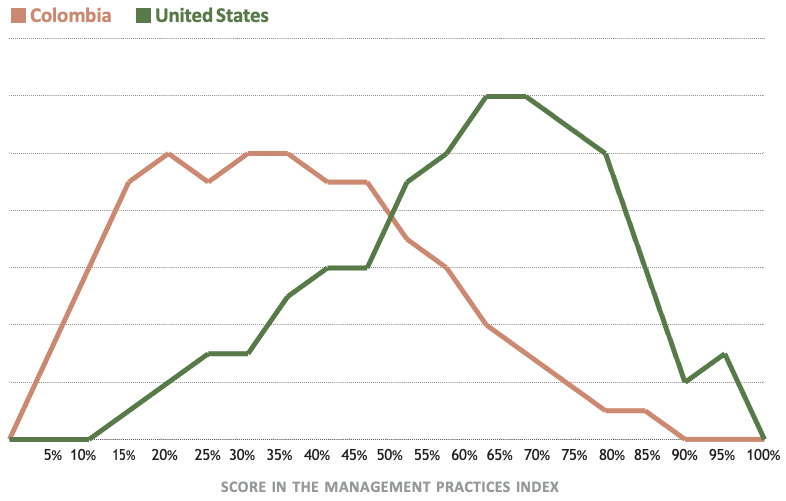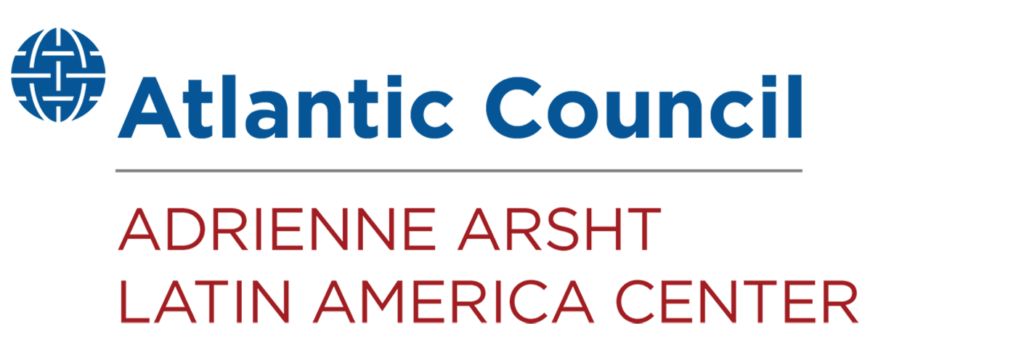Improve productivity
Juan lives in Bogota and has been a construction worker for twenty-five years. His brother Pedro, also a construction worker, lives in Los Angeles, California. To Pedro’s surprise, when he compared the results of their respective jobs, he realized he produced much more than his brother in Colombia in the same amount of time. In other words, his productivity far outpaced Juan’s, and thus, his income was much higher.
This efficiency in using time, characteristic of the United States, is not a product of chance. High labor productivity—five times higher than Colombia’s—is the result of technology, training of the labor force, and adequate regulation for business development, among other factors.
This high productivity also explains, in large part, the enormous gap between the per capita income of the United States and Colombia. World Bank estimates1Ana Paola Cusolito and William F. Maloney, Productivity Revisited: Shifting Paradigms in Analysis and Policy(Washington, DC: World Bank Group, 2018), http://documents.worldbank.org/curated/ en/578861548876206044/Productivity-Revisited-Shifting-Paradigms-in-Analysis-and-Policy. show that close to 50 percent of the differences between the countries’ per capita incomes can be explained by disparities in productivity. In other words, the main barrier to convergence with developed countries’ income levels is lagging productivity.
Colombia urgently needs to grow at high and sustained rates to increase economic and social development and, above all, become a more inclusive society. The current levels of monetary poverty of 42.5 percent and extreme poverty of 15.2 percent, exacerbated by the COVID-19 pandemic, are unacceptable, as are the figures for business and labor informality. The latter is close to 63 percent and is mostly concentrated among women.2DANE – National Administrative Department of Statistics of Colombia website, accessed March 1, 2022, https://www.data4sdgs.org/partner/dane-national-administrative-department-statistics-colombia.
Pivotal to achieving this transformation is improving productivity, the most critical determinant of per capita income growth in the long term and, therefore, poverty reduction. Without productivity, there is no growth, no sustainability, no equality, and no inclusion.
A bilateral agenda based on productivity
Undoubtedly, Colombia’s primary objective in increasing productivity is to improve the welfare of its population in a sustainable and sustained manner. Achieving this would have very positive external repercussions well worth considering. For example, for the United States, a more efficient and sophisticated Colombian productive apparatus would provide a reliable and long-term commercial partner with high-quality standards and reasonable prices, in addition to the valuable advantage of geographical proximity.
In recognition of the positive impact on both countries, the bilateral agenda should also focus on working together to improve Colombia’s productivity. What better occasion to do so than the bicentennial of bilateral relations?
There is no such initiative, but scaling up existing programs such as the Productive Factories Program of Colombia Productiva of the Ministry of Commerce, Industry and Tourism or replicating them in different sectors or regions could provide a solution.
According to international evidence, policies to increase productivity should focus on three fronts: productivity gains within firms, efficient real- location of resources from low-productivity to high-productivity businesses, and free entry of high-productivity enterprises and the exit of low-productivity ones.3Cusolito and Maloney, Productivity Revisited: Shifting Paradigms in Analysis and Policy.
In Colombia, despite the importance of these three factors, the first— productivity increases within companies—is the most relevant, according to an analysis of the evolution of productivity in several companies.4Productividad:laclavedelcrecimientoparaColombia, Consejo Privado de Competitividad and Universidad de los Andes, 2017, https://compite.com.co/proyecto/productividad/. Around 65 percent of productivity increases are due to improvements in production processes and better product positioning.
Therefore, the most advisable work within companies would be techno- logical extension and technical assistance programs, such as the previously mentioned Productive Factories Program, which has had positive results and became the star program of President Iván Duque’s effort to increase productivity at the firm’s level. It most definitely is a program that should be continued and strengthened by incoming governments.
Productive factories
The Productive Factories Program is a solid example of cooperation between Colombia and the United States. The Georgia Institute of Technology (Georgia Tech) and the Ministry of Commerce, Industry and Tourism united to increase business productivity and competitiveness by applying new technologies. The program was created in 2019, inspired by the technology extension model (Manufacturing Extension Partnership [MEP] and Georgia Tech MEP). It emerged from an initiative involving the public and private sectors in 2017 to transfer methodologies to Colombia and train in technology extension methods. Georgia Tech’s EI2 Business Innovation Institute supported its design and implementation.5Mónica Novoa, “Success Story: Design and Implementation of Technology Extension Services (TES) in Colombia,” Georgia Tech Enterprise Innovation Institute, August 23, 2021, https:// innovate.gatech.edu/uncategorized/success-story-design-and-implementation-of-technology- extension-services-tes-in-colombia/.
The program’s first phase involved training and certifying 150 Colombian extensionists at Georgia Tech, who then returned to the country to work together with twenty-five Georgia Tech EI2 professionals in a pilot program in forty companies and four cities, transferring their knowledge.
Based on these lessons learned, the program was extended to all regions of the country, with very positive results, precisely because of its ability to reach the heart of companies with specialized services through coordinated work with chambers of commerce and public-private partners.
According to Colombia Productiva, the program has 850 productivity experts in quality management, digital transformation, logistics, energy efficiency, productivity, and commercial management. It has served more than 4,000 companies of all sizes, improving their productivity indicators by more than 31 percent, above the initial 8 percent goal.6El camino hacia la productividad: Evolución de Fábricas de Productividad 2018 – 2021, Colombia Productiva, accessed March 5, 2022, https://www.colombiaproductiva.com/ptp-capacita/ publicaciones/transversales/el-camino-de-la-productividad.
In evaluations conducted by Fedesarrollo and UT Econometría-SEI, the program was well-rated, with its high design standards and a positive perception of quality highlighted. However, both evaluations drew attention to the program’s limited scope in terms of economic and human resources to reach the bulk of the business sector.
Scaling up
To visualize the magnitude of the productivity challenge, it is mandatory to characterize the Colombian business world. Unfortunately, limited information is available since an economic and business census has not been conducted since 1991 due to a lack of resources. Contributing resources to carry out this census is fundamental and a possible front for bilateral collaboration.
According to the National Administrative Department of Statistics (DANE), Clombia has few large companies and many informal micro-busi- nesses (ten million).7DANE – National Administrative Department of Statistics of Colombia website, accessed March 1, 2022, https://www.data4sdgs.org/partner/dane-national-administrative-department-statistics-colombia. These are not very productive and employ almost half of the country’s workers, accounting for the high level of labor informality. Medium-sized companies, on the other hand, are practically nonexistent.
According to the Single Business Registry, there were about 1,643,000 registered companies in 2019, of which 20,000 had more than fifty workers. By August 2021, the number of registered companies fell by 18 percent due to the COVID-19 pandemic.8All formal firms are required to register at the local Chamber of Commerce and the Registro Único Empresarial (RUES); the Single Business Registry is the sum of these registries. See the Registro Único Empresarial website, accessed March 5, 2022, https://www.rues.org.co/.
Technology adoption in Colombia, an essential determinant of productivity, lags far behind. Although most companies have computers, internet access, and a webpage, the use given to these tools is basic: sending e-mails, searching for information, or accessing electronic banking.
Perhaps the most critical for business transformation and where the greatest challenge lies is in the quality of management. According to surveys conducted by the Colombian National Planning Department (DNP), the level of management practices in Colombian companies is lower than in developed countries. As seen in the following graph, a company in Colombia obtains half the management practices score as that obtained by a com- parable US company. In Colombia, the average is 0.38 percent; in the United States, it is 0.62 percent. This lack of management quality also explains why Colombian companies are less innovative.
Distribution of managerial skills in Colombia and the United States, 2018

DNP, based on DANE(2018) and MOPS9 Management and Organizational Practices Survey (MOPS). (2018).
Poor training at the managerial level is a major impediment to business transformation since those in charge are unable to ask the right questions regarding human capital requirements, technological change, and innovation, for example. As the President of Georgia Tech, Ángel Cabrera, said at the recent meeting of the Productive Factories Program, “transforming an economy requires business leaders who turn talent into ideas in the twenty-first century.”10Colombia Productiva, “Facebook Live,” accessed March 5, 2022, https://www.facebook.com/ ColombiaProductiva/videos/694015008444716.
Thus, to improve the productivity of the Colombian economy for the benefit of both countries, it is necessary to concentrate efforts on developing managerial capabilities through technological extension and technical assistance by scaling up the Productive Factories Program or developing similar programs.
Given that Productive Factories originated in the United States and its design and methodology have proven successful, the best way forward is to scale up this program by accessing financial resources or scholarships for training extension workers on various productivity fronts. This is undoubtedly the most efficient way to address the needs of companies and improve their capabilities. The training could be done in the United States, as was the case of the extensionists trained at Georgia Tech, or the methodology for training could be transferred to Colombia.
What is clear is that knowledge must be multiplied to transform the country.
The challenge, although ambitious, is well known, and there is a proven way to meet it. Joint work between Colombia and the United States would make it possible to achieve the desired impact—a more developed and inclusive country for the benefit of Colombians, which would also benefit the United States. And more importantly, it would reduce the gap between Pedro’s and Juan’s income, allowing both brothers to finally enjoy a similar quality of life.
Related Allies essays
A roadmap for a new type of engagement
This moment opens the door for a reimagined US partnership with Colombia based on a shared vision for a more prosperous, inclusive, and sustainable future.
Related program

The Adrienne Arsht Latin America Center broadens understanding of regional transformations and delivers constructive, results-oriented solutions to inform how the public and private sectors can advance hemispheric prosperity.
Image: An aerial view of the Gatun locks on the Atlantic side of the Panama Canal is seen during an organised media tour by Italy's Salini Impregilo, one of the main sub contractors of the Panama Canal Expansion project on the outskirts of Colon City March 23, 2015. The expansion project area will allow bigger ships to transit, with two new sets of locks, one on the Pacific side and one on the Atlantic side. REUTERS/Carlos Jasso



